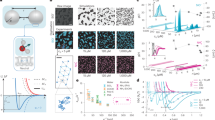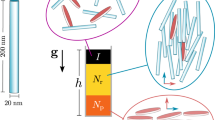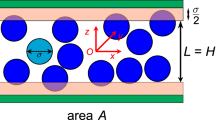Abstract
The existence of long-range attractive electrostatic forces between particles of like charge is one of the great current controversies ofcolloid science. The established theory (Derjaguin–Landau–Vervey–Overbeek; DLVO) of colloidal interactions predicts that an isolated pair of like-charged colloidal spheres in an electrolyte should experience a purely repulsive screened electrostatic (coulombic) interaction1,2. Direct measurements of such interactions have shown quantitative agreement with DLVO theory3,4,5. Recent experiments, however, provide evidence that the effective interparticle potential can have a long-range attractive component in more concentrated suspensions6,7 and for particles confined by charged glass walls3,5,8,9,10. It is apparent that the long-range attraction in concentrated systems is due to multi-body interactions and may have a similar explanation to the attraction observed for otherwise confined colloids. Theoretical explanations have been proposed11,12,13 but remain the subject of controversy14,15. Here we present a quantitative theoretical explanation of these attractive forces between confined colloidal particles, based on direct solutions of the nonlinear Poisson–Boltzmann equation for two like-charged spheres confined in a cylindrical charged pore. The calculations show that the attraction may be explained by the redistribution of the electric double layers of ions and counterions in solution around the spheres, owing to the presence of the wall; there is thus no need to revise the established concepts underlying theories of colloidal interactions.
This is a preview of subscription content, access via your institution
Access options
Subscribe to this journal
Receive 51 print issues and online access
$199.00 per year
only $3.90 per issue
Buy this article
- Purchase on Springer Link
- Instant access to full article PDF
Prices may be subject to local taxes which are calculated during checkout



Similar content being viewed by others
References
Derjaguin, B. V. & Landau, L. Theory of the stability of strongly charged lyophobic sols and the adhesion of strongly charged particles in solutions of electrolytes. Acta Physicochimica (USSR) 14, 633 (1941).
Verwey, E. J. & Overbeek, J. Th. G. Theory of the Stability of Lyophobic Colloids (Elsevier, Amsterdam, (1948)).
Crocker, J. C. & Grier, D. G. Microscopic measurements of pair interaction potential of charge-stabilised colloid. Phys. Rev. Lett. 73, 352–355 (1994).
Crocker, J. C. & Grier, D. G. Methods of digital video microscopy for colloidal studies. J. Coll. Interface Sci. 179, 298–310 (1996).
Grier, D. G. Optical tweezers in colloid and interface science. Curr. Opin. Coll. Interface Sci. 2, 264–270 (1997).
Larsen, A. E. & Grier, D. G. Like-charge attractions in metastable colloidal crystallites. Nature 385, 230–233 (1997).
Ise, N., Okubo, T., Sugimura, M., Ito, K. & Nolte, H. J. Ordered structure in dilute solutions of highly charge polymers lattices as studied by microscopy. I. Interparticle distance as a function of latex concentration. J. Chem. Phys. 78, 536–540 (1983).
Kepler, G. M. & Fraden, S. Attractive potential between confined colloids at low ionic strength. Phys. Rev. Lett. 73, 356–359 (1994).
Carbajal-Tinoco, M. D., Castro-Roman, F. & Arauz-Lara, J. L. Static properties of confined colloidal suspensions. Phys. Rev. E 53, 3745–3749 (1996).
Crocker, J. C. & Grier, D. G. When like charge particles attract: the effects of geometrical confinement on long-range colloidal interactions. Phys. Rev. Lett. 77, 1897–1900 (1996).
Sogami, I. Effect potential between charged spherical particle in dilute suspension. Phys. Lett. A 96, 199–203 (1983).
Sogami, I. & Ise, N. On the electrostatic interaction in macroionic solutions. J. Chem. Phys. 81, 6320–6332 (1984).
Chu, X. & Wasan, D. Attractive interaction between similarly charged colloidal particles. J. Coll. Interface. Sci. 184, 268–278 (1996).
Jönsson, B., Åkesson, T. & Woodward, C. E. in Ordering and Phase Transitions in Colloidal Systems (eds Arora, A. K. & Tata, B. V. R.) Ch. 11, 295–313 (VCH, New York, (1996)).
Smalley, M. V. in Ordering and Phase Transitions in Colloidal Systems (eds Arora, A. K. & Tata, B. V. R.) Ch. 12, 315–337 (VCH, New York, (1996)).
Bowen, W. R. & Sharif, A. O. Adaptive finite element solution of the non-linear Poisson–Boltzmann equation: a charged spherical particle at various distances from a charged cylindrical pore in a charged planar surface. J. Coll. Interface Sci. 187, 363–374 (1997).
Russel, W. B., Saville, D. A. & Schowalter, W. R. Colloidal Dispersions (Cambridge Univ. Press, (1989)).
Hastings, R. On the crystallisation of macroionic solutions. J. Chem. Phys. 68, 675–678 (1978).
van Roij, R. & Hansen, J-P. Van der Waals-like instability is suspensions of mutually repelling charged colloids. Phys. Rev. Lett. 79, 3082–3085 (1997).
Tata, B. V. R., Yamahara, E., Rajamani, P. V. & Ise, N. Amorphous clustering in highly charged dilute poly(chlorostyrene-styrene sulfonate) colloids. Phys. Rev. Lett. 78, 2660–2663 (1997).
Acknowledgements
This work was funded by the UK Biotechnology and Biological Sciences Research Council.
Author information
Authors and Affiliations
Corresponding author
Rights and permissions
About this article
Cite this article
Bowen, W., Sharif, A. Long-range electrostatic attraction between like-charge spheres in a charged pore. Nature 393, 663–665 (1998). https://doi.org/10.1038/31418
Received:
Accepted:
Issue Date:
DOI: https://doi.org/10.1038/31418
This article is cited by
-
Increasing the stability of DNA-functionalized gold nanoparticles using mercaptoalkanes
Journal of Nanoparticle Research (2008)
-
A Finite Difference Method and Analysis for 2D Nonlinear Poisson–Boltzmann Equations
Journal of Scientific Computing (2007)
-
Colloidal interactions: contact limiting laws, double-layer dissociation, and "non-DLVO" (Derjaguin–Landau–Verwey–Overbeek) forces
Colloid and Polymer Science (2003)
-
Origin of anomalous multibody interactions
Nature (1999)
-
Erratum: correction Long-range electrostatic attraction between like-charge spheres in a charged pore
Nature (1999)
Comments
By submitting a comment you agree to abide by our Terms and Community Guidelines. If you find something abusive or that does not comply with our terms or guidelines please flag it as inappropriate.



